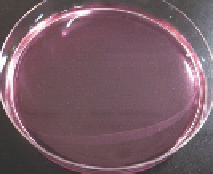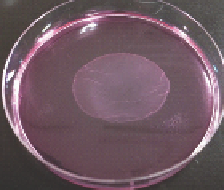Biomedical Engineering Reference
In-Depth Information
A
B
Isolated
Cells
37 °C
PIPAAm
Temperature-responsive
culture dis
h
Detaching cell
sheet
Cell proliferation
Con
f
lu
e
nt
Cells
37 °C
Cell proliferation
Cell surface protein
Cell-cell junction
ECM
Swelling
PIPAAm
20 °C
Cell sheet layering
Detached cell
sheet
Three-dimensional tissue
re-construction
Figure 4b.1
Cell sheet-based tissue engineering allows us to fabricate a
cell-dense 3D tissue, as schematically shown in (A). Isolated
cells on a PIPAAm-grafted temperature-responsive culture
dish can be recovered as a biologically functional and
communicative cell sheet, which preserves cell-cell junctions,
cell surface proteins, and the ECM, by lowering its temperature
(37°C
Æ
20°C). The upper photograph in (B) is a detaching cell
sheet (white arrow), and the lower photograph is a detached
cell sheet (dashed circle). Both dishes are 100 mm culture
dishes.
by temperature changes is only observed on 20 nm thick PIPAAm-
grafted surfaces and cells rarely attach to grafted layers that are
thicker than 30 nm [17]. The grafted polymer thickness can be
controlled by the concentration of IPAAm monomers and the
radiation energy of the EB. Since cell sheets can be recovered by
simply changing the temperature without protease treatment, the
cell-cell junctions and ECM components mediating cell adhesion,
which are susceptible to protease treatment, are preserved intact
[18-20]. Because cell sheets preserve cell-cell junctions and the
ECM, 3D tissue can be easily fabricated by simply layering cell sheets
without any scaffolds, resulting in functional and communicative
cell-dense tissue. Three-dimensional myocardial tissue fabricated by









































































































